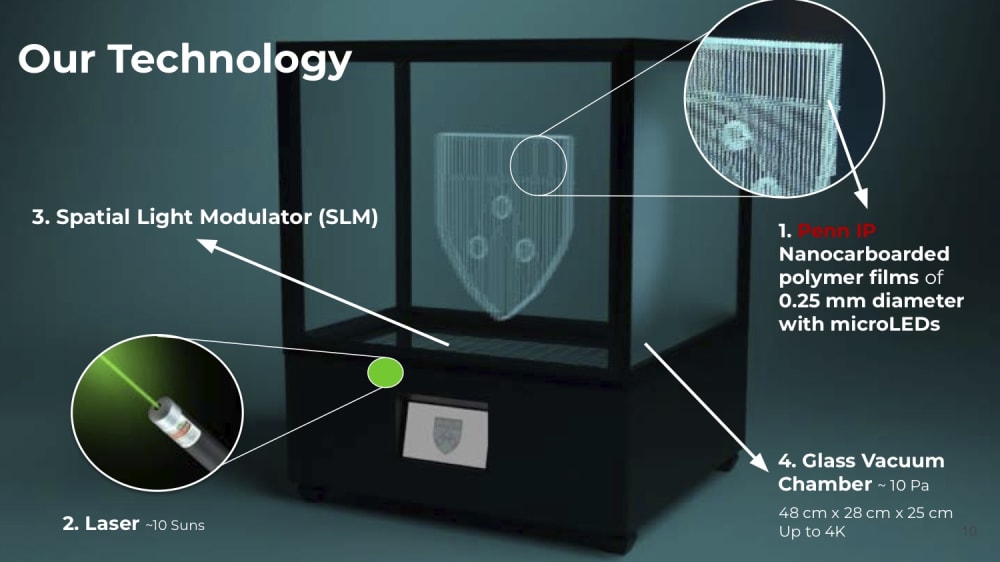
In laparoscopic and robotic surgeries, surgeons make decisions by solely looking at the live video of their surgical field. This presents a problem with depth perception as surgeons view a 3D field in two dimensions, leading to long training time and increased complications. In fact, 1 in 5 surgical injuries are linked to poor visualization.
Our technology is a full-colored volumetric 3D display that will revolutionize surgical visualization. Based on IP from the University of Pennsylvania, the display’s pixels are microflyers - nanocarboarded polymer films of 0.25 mm diameter with payloads of colored microLEDs. These microflyers levitate to various altitudes upon incident laser light of 10 Suns intensity that has been patterned by a spatial light modulator (SLM). Their mechanism for levitation is photophoretic and is researched by the Bargatin group (we have their permission to use their technology). This is all packaged in a glass vacuum chamber to enable low pressures and prevent the laser light from escaping the box's coated polarizer.
Surgeons choose VoluVision over other 3D displays. This is because other 3D displays in the market currently have very significant flaws.
- Stereoscopic displays such as Hypervsn are uncomfortable to use as the viewer is presented with a different image in each eye
- Multi-view displays such as Looking Glass and Holoxica don't enable viewing from all angles because they rely on dividing the image into multiple views
- Holographic displays such as Realfiction and Olomagic don't enable viewing from all angles as well since commercially available SLMs don’t reach the resolution required for it
- Other volumetric displays in the market such as Voxon Photonics project points of light into 3D space and suffer from image transparency
Our market research states that the ideal 3D Display for surgical visualization would be one with a 360-degree field of view and high image quality. Volusion is the only display in the market that can achieve both - solid microflyers as pixels mean that image transparency isn't a problem and that the image is viewable from all angles with no discomfort.
Our team shadowed Dr. Sean Harbison at Penn Medicine and our trip confirmed that VoluVision would be very useful for surgeons. In fact, VoluVision can increase revenue for hospitals by decreasing complications and training time.
The product would be manufactured as part of a graduate student’s research thesis or by licensing the technology to a company. The customer acquisition plan involves placement of prototypes at Penn Medicine then progressing to more hospitals in the US as well as partnerships with laparoscopic companies such as CONMED, Ethicon, and Medtronic, post FDA-510k approval. Our financial projection estimates a gross profit margin of 20.1 % at $50,000 per VV and the cost of production analysis estimates a total cost of around $40,000 per display. Lastly, we believe that VoluVision has not only the potential to disrupt the surgical visualization field (market size $56.5 B by 2028) but the Entertainment (Market Size $426.9B by 2027) and Global Telecommunications (Market Size $2.5T by 2031).
Video
-
Awards
-
 2023 Top 100 Entries
2023 Top 100 Entries
Like this entry?
-
About the Entrant
- Name:Tarunyaa Sivakumar
- Type of entry:teamTeam members:
- Lavanya Neti
- Rohana Gullapalli
- Benjamin Chan
- Gavin Hart
- Joy Gong
- Software used for this entry:Maya
- Patent status:none









